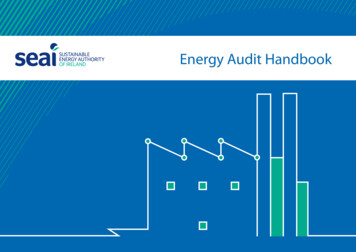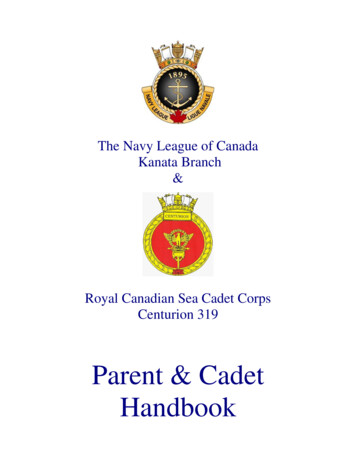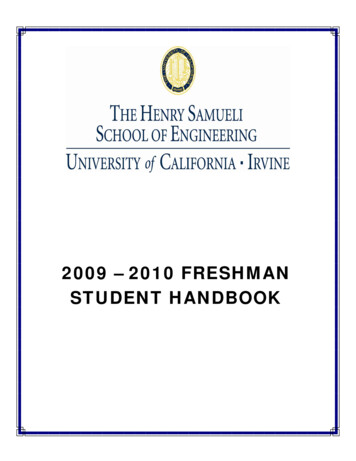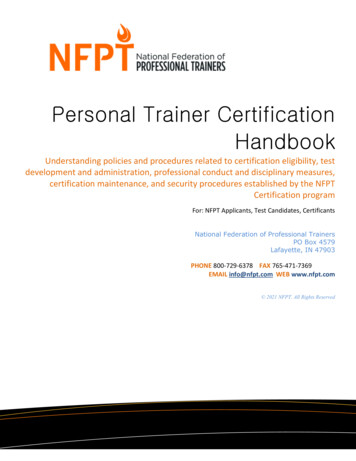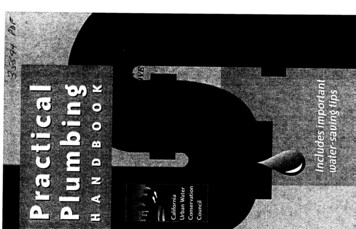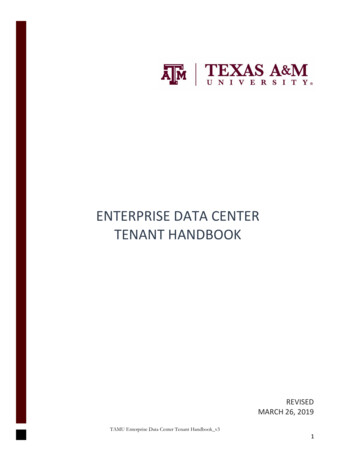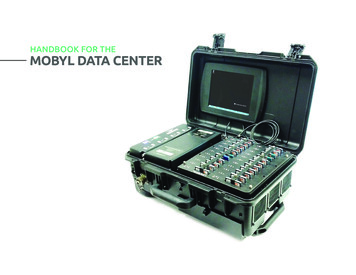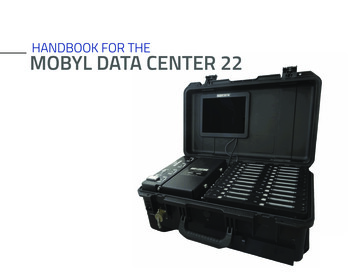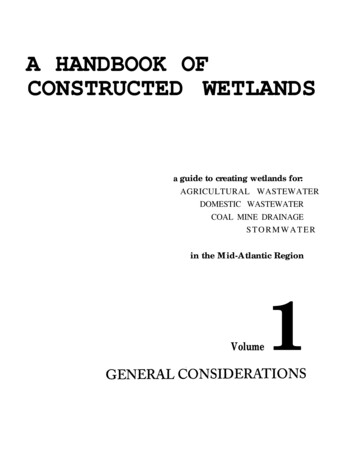
Transcription
A HANDBOOK OFCONSTRUCTED WETLANDSa guide to creating wetlands for:AGRICULTURAL WASTEWATERDOMESTIC WASTEWATERCOAL MINE DRAINAGESTORMWATERin the Mid-Atlantic RegionVolume1
ACKNOWLEDGMENTSMany people contributed to this Handbook. An interagency Core Group provided the initial impetus for the Handbook, and later providedguidance and technical input during its preparation. The Core Group comprised:Carl DuPoldt, USDA - NRCS. Chester, PARobert Edwards, Susquehanna River Basin Commission,Harrisburg, PALamonte Garber, Chesapeake Bay Foundation, Harrisburg. PABarry Isaacs, USDA - NRCS, Harrisburg, PAJeffrey Lapp. EPA, Philadelphia, PATimothy Murphy, USDA - NRCS, Harrisburg, PAGlenn Rider, Pennsylvania Department of EnvironmentalResources, Harrisburg. PAMelanie Sayers, Pennsylvania Department of Agriculture, Harrisburg, PAFred Suffian, USDA - NRCS Philadelphia, PACharles Takita, Susquehanna River Basin Commission, Harrisburg, PAHarold Webster, Penn State University, DuBois, PA.Many experts on constructed wetlands contributed by providing information and by reviewing and commenting on the Handbook. TheseIndividuals included:Robert Bastian. EPA .WashinSton, DCRobert Knight, CH2M HILL, Gainesville, FLFran Koch, Pennsylvania Department ofWilliam Boyd, USDA - NRCS. Lincoln, NEEnvironmental Resources, Harrisburg, PARobert Brooks, Penn State University,University Park, PAEric McCleary, Damariscotta, Clarion, PADonald Brown, EPA, Cincinnati, OHGerald Moshiri, Center for Wetlands andEco-Technology Application, Gulf Breeze,Dana Chapman, USDA - NRCS, Auburn, NYFLTracy Davenport, USDA -NRCS, Annapolis,JohnMurtha, Pennsylvania Department ofMDEnvironmental Resources, Harrisburg. PAPaul DuBowy, Texas A & M University,Robert Myers, USDA - NRCS, Syracuse, NYCollege Station, TXKurt Neumiller, EPA, Annapolis, MDMichelle Girts, CH2M HILL, Portland, ORRichard Reaves, Purdue University, WestRobert Hedin, Hedin Environmental,Lafayette, INSewickley, PAWilliamSanville, EPA, Cincinnati, OHWilliam Hellier. Pennsylvania Department ofEnvironmental Resources, Hawk Run, PADennis Sievers, University of Missouri,Columbia, MORobert Kadlec, Wetland ManagementServices, Chelsea, MIEarl Shaver, Delaware Department ofNatural Resources and EnvironmentalDouglas Kepler, Damariscotta. Clarion, PAControl, Dover, DERobert Kleinmann, US Bureau of Mines,Pittsburgh, PADaniel Seibert, USDA - NRCS, Somerset, PAJeffrey Skousen, West Virginia University,Morgantown. WVPeter Slack, Pennsylvania Department ofEnvironmental Resources, Harrisburg, PADennis Verdi, USDA - NRCS, Amherst, MAThomas Walski, Wilkes University, WilkesBarre, PARobert Wengryznek, USDA - NRCS, Orono,MEAlfred Whitehouse, Office of SurfaceMining. Pittsburgh, PAChristopher Zabawa, EPA, Washington, DC.This document was prepared by Luise Davis for the USDA-Natural Resources Conservation Service and the US Environmental ProtectionAgency-Region III, in cooperation with the Pennsylvania Department of Environmental Resources. Partial funding has been provided withnonpoint source management program funds under Section 319 of the Federal Clean Waler Act.The findings. conclusions, and recommendations contained in the Handbook do not necessarily represent the policy of the USDA - NRCS,EPA - Region III, the Commonwealth of Pennsylvania, or any other state in the northeastern United States concerning the use of constructedwetlands for the treatment and control of nonpoint sources of pollutants. Each state agency should be consulted to determine specificprograms and restrictions in this regard.
VOLUME 1TABLE OF CONTENTSCHAPTER 1. INTRODUCTION . . . . . . . . . . . . . . . . . . . ., .5CHAPTER 2. CONSTRUCTED WETLANDS AS ECOSYSTEMS . 7What Are Wetlands? . . . . 7Wetland Functions and Values. . . . 7Components of Constructed Wetlands .8Water. . .Substrates, Sediments, and Litter .Vegetation .Microorganisms .Animals. . .88899Aesthetics and Landscape Enhancement . 10CHAPTER 3. CONSTRUCTED WETLANDS AS TREATMENT SYSTEMS . 11How Wetlands Improve Water Quality .11Advantages of Constructed Wetlands. . . . . . . . . . . . . . . . . . . . . . . . . . . . . . . . . 11Limitations of Constructed Wetlands . 11Types of Constructed Wetlands . 1213Surface Flow Wetlands . . . . . . . . . . . . . . . . . . . . . . . . . . . . . . . . . . . . . . . . . . . . . . . . . . . . . . . . . . .Subsurface Flow Wetland .Hybrid Systems .Winter and Summer Operation .Creation of Hazard .Change and Resilience . . .1313131414CHAPTER 4. GENERAL DESIGN OF CONSTRUCTED WETLANDS . 17Design Considerations . 17Planning . 17Site Selection . . 18Land Use and Access. . . 18Land Availability . 18Topography . 19Environmental Resources. . . 19Permits and Regulations . 19Structures . . 2020Cells .20Liners .Flow Control Structures . 20Inlets . 21Outlets . . 22System Lifetimes .23
Chapter 5. HYDROLOGY .Climate and Weather .2525Hydroperiod . . . 25Hydraulic Residence Time .Hydraulic Loading Rate .Groundwater Exchange .Evapotranspiration .26262626Water Balance .26Chapter 6. SUBSTRATES. . . .Soil .Sand and Gravel .Organic Material . .292939Chapter 7, VEGETATION . . .Selecting plants . .Surface Flow Wetlands .Subsurface Flow W e t l a n d s . . .313131343434343435353630Sources of Plants . . .Seeds . . .Wetland Soil . .Rhizomes,Tubers. and Entire Plants .When To Plant. .Site Preparation .How To Plant .Surface Flow Wetlands. . . . 36Subsurface Flow Wetlands . . . . 36Establishing and Maintaining Vegetation . 36Chapter 8. CONSTRUCTION .Construction Plans .Pre-Construction Activities .Construction Activities . . .Inspection, Startup, and Testing .39393939Chapter 9: OPERATION, MAINTENANCE, AND MONITORING .Operation and Maintenance .Operation and Maintenance Plan . .:. .Hydrology .Structures .Vegetation .Muskrats .Mosquitoes .Monitoring .Monitoring Plan. .Monitoring for Discharge Compliance. .Monitoring for System Performance .Monitoring for Wetland Health .4141404141414242424343434344
REFERENCES .I . . . . . . . . . . . . . . . . . . . . . . . . . . . . . . . . . . . . . . . . . . . . . . . . . . . . . . . . . . . . . . . . . . . . . . . . . . . . . . . . . . . . . . . . . . . . . . . . . . . . . . . . . . . . . . . . . . . . . . . . . .45PHOTOGRAPHS . . . . . . . . . . . . . . . . . . . . . . . . . . . . . . . . . . . . . . . . . . . . . . . . . . . . . . . . . . . . . . . . . . . . . . . . . . . . . . . . . . . . . . . . . . . . . . . . . . . . . . . . . . . . . . . . . . . . . . . . . 47LIST OF TABLES.Table 1. Emergent plants for constructed wetlands . . . . . . . . . . . . . . . . . . . . . . . . . . . . . . . . . . . . . . . . . . . . . . . . . . . . . . . . . . . . . . . . . . . . . . . . . . . . . . . . . . . . . . . . . . 32LIST OF FIGURESFigure 1. Surface flow and subsurface flow constructed wetlands . .12Figure 2. Inlet and outlet designs . 21Figure 3. Influent splitter box . 22
Natural processes have always cleansedwater as it flowed through rivers, lakes, streams,and wetlands. In the last several decades,systems have been constructed to use some ofthese processes for water quality improvement.Constructed wetlands are now used to improvethe quality of point and nonpoint sources ofwater pollution, including stormwater runoff,domestic wastewater, agricultural wastewater,and coal mine drainage. Constructed wetlandsare also being used to treat petroleum refinerywastes, compost and landfill leachates, fishpond discharges, and pretreated industrialwastewaters, such as those from pulp and papermills, textile mills, and seafood processing. Forsome wastewaters, constructed wetlands are thesole treatment; for others, they are one component in a sequence of treatment processes.One of the most common applications ofconstructed wetlands has been the treatment ofprimary or secondary domestic sewage effluent.Constructed wetland systems modelled afterthose for domestic wastewater are being used totreat the high organic loads associated withagriculture. A large number of wetlands havebeen constructed to treat drainage from activeand abandoned coal mines and more than 500such systems are operating in Appalachia alone.The use of constructed wetlands to controlstormwater flows and quality is a recent application of the technology and the number of suchsystems is increasing rapidly.The treatment of wastewater or stormwaterby constructed wetlands can be a low-cost, lowenergy process requiring minimal operationalattention. As a result of both extensive researchand practical application, insight is being gainedinto the design, performance, operation, andmaintenance of constructed wetlands for waterquality improvement. Constructed wetlands canbe sturdy, effective systems. However, to beeffective, they must be carefully designed,constructed, operated, and maintained.This Handbook has been prepared as ageneral guide to the design, construction, operation, and maintenance of constructed wetlandsfor the treatment of domestic wastewater, agricultural wastewater, coal mine drainage, andstormwater runoff in the mid-Atlantic region,The Handbook is not a design manual. The useof constructed wetlands to improve water qualityis a developing technology. Much is not yetunderstood, and questions remain regarding theoptimal design of wetland systems and theirlongevity. As our experience with these systemsincreases, the information offered here will bereplaced by more refined information. TheHandbook should be used with this clearly inmind.The Handbook is divided into five volumes.This, the first, provides information common toall types of constructed wetlands for wastewaterand runoff. It is to be used in conjunction withan accompanying volume that provides information specific to a particular type of wastewater orrunoff. The other volumes in the series areVolume 2: Domestic Wastewater, Volume 3:Agricultural Wastewater, Volume 4: Coal MineDrainage, and Volume 5: Stormwater Runoff.While constructed wetlands are being used totreat other kinds of wastewater, such as industrial wastewaters, a discussion of these applications is beyond the scope of this Handbook.However, the information presented here may beuseful in developing other applications.A number of conferences on constructedwetlands have been held recently. The proceedings of these conferences include experimentaland operational data from wetland systems builtto treat a number of different kinds of wastewaters and runoff, and present detailed discussionsof process kinetics and system design. Proceedings from three well-known conferences are:Moshiri, G. A. (ed.) 1993. Constructed Wetlandsfor Water Quality Improvement. CRC Press, BocaRaton, FL. 632 pp.V O L U M E 1: G E N E R A L C O N S I D E R A T I O N S5
Cooper, P. F., and B. C. Findlater (eds.) 1990.Constructed Wetlands in Water Pollution Control.Proceedings of the International Conference onthe Use of Constructed Wetlands in Water Pollution Control. Cambridge, UK, 24-28 September.WRc, Swindon, Wiltshire, UK. 605 pp.Hammer, D. A. (ed.) 1989. Constructed Wetlandsfor Wastewater Treatment: Municipal, Industrialand Agricultural. Lewis Publishers. Chelsea, MI.831 pp.Conferences and published’ information continueto become available as more constructed wetlandsystems are built and monitored.VO L U M E1 :GEN E R A LCO N S I D E R A T I O N
CHAPTER 2CONSTRUCTED WETLANDS AS ECOSYSTEMSConstructed wetlands for water treatmentare complex, integrated systems of water,plants, animals, microorganisms, and theenvironment. While wetlands are generallyreliable, self-adjusting systems, an understanding of how natural wetlands are structured andhow they function greatly increases the likelihood of successfully constructing a treatmentwetland. This chapter provides an overview ofthe major components of wetland ecosystemsand of the most important processes that affectwater treatment.WHAT ARE WETLANDS?Wetlands are transitional areas between landand water. The boundaries between wetlandsand uplands or deep water are therefore notalways distinct. The term “wetlands” encompasses a broad range of wet environments,including marshes, bogs, swamps, wet meadows,tidal wetlands, floodplains, and ribbon (riparian)wetlands along stream channels.All wetlands - natural or constructed, freshwater or salt - have one characteristic in common: the presence of surface or near-surfacewater, at least periodically. In most wetlands,hydrologic conditions are such that the substrateis saturated long enough during the growingseason to create oxygen-poor conditions in thesubstrate. The lack of oxygen creates reducing.(oxygen-poor) conditions within the substrateand limits the vegetation to those species that areadapted to low-oxygen environments.The hydrology of wetlands is generally oneof slow flows and either shallow waters orsaturated substrates. The slow flows and shallow water depths allow sediments to settle as thewater passes through the wetland. The slowflows also provide prolonged contact timesbetween the water and the surfaces within thewetland. The complex mass of organic andVOLUME 1inorganic materials and the diverse opportunitiesfor gas/water interchanges foster a diverse community of microorganisms that break down or transform a wide variety of substances.Most wetlands support a dense growth ofvascular plants adapted to saturated conditions.This vegetation slows the water, creates microenvironments within the water column, and providesattachment sites for the microbial community.The litter that accumulates as plants die back inthe fall creates additional material and exchangesites, and provides a source of carbon, nitrogen,and phosphorous to fuel microbial processes.WETLAND FUNCTIONSAND VALUESWetlands provide a number of functions andvalues. (Wetland functions are the inherentprocesses occurring in wetlands; wetland valuesare the attributes of wetlands that society perceives as beneficial.) While not all wetlandsprovide all functions and values, most wetlandsprovide several. Under appropriate circumstances.constructed wetlands can provide:water quality improvementflood storage and the desynchronization of stormrainfall and surface runoffcycling of nutrients and other materialshabitat for fish- and wildlifepassive recreation, such as bird watchingand photographyactive recreation, such as huntingeducation and researchaesthetics and landscape enhancemerit.’G ENERAL C O N S I D E R A T I O N S7
COMPONENTS OFCONSTRUCTED WETLANDSAconstructed wetland consists of a properlydesigned basin that contains water, a substrate, and,most commonly, vascular plants. These componentscan be manipulated in constructing a wetland. Otherimportant components of wetlands, such as thecommunities of microbes and aquatic invertebrates,develop naturally.WATERWetlands are likely to form where landformsdirect surface water to shallow basins and where arelatively impermeable subsurface layer prevents thesurface water from seeping into the ground. Theseconditions can be created to construct a wetland. Awetland can be built almost anywhere in the landscape by shaping the land surface to collect surfacewater and by sealing the basin to retain the water.Hydrology is the most important design factor inconstructed wetlands because it links all of thefunctions in a wetland and because it is often theprimary factor in the success or failure of a constructed wetland. While the hydrology of constructed wetlands is not greatly different than that ofother surface and near-surface waters, it does differ inseveral important respects:lllsmall changes in hydrology can have fairly significant effects on a wetland and its treatment effectivenessbecause of the large surface area of the water andits shallow depth, a wetland system interactsstrongly with the atmosphere through rainfall andevapotranspiration (the combined loss of water byevaporation from the water surface and lossthrough transpiration by plants)the density of vegetation of a wetland strongly affectsits hydrology, first, by obstructing flow paths as thewater finds its sinuous way through the network ofstems, leaves, roots, and rhizomes and, second, byblocking exposure to wind and sun.S U B S T R A T E S, SE D I M E N T S,ANDLITTERSubstrates used to construct wetlands include soil, sand, gravel, rock, and organicmaterials such as compost. Sediments and litterthen accumulate in the wetland because of thelow water velocities and high productivitytypical of wetlands. The substrates, sediments,and litter are important for several reasons:llthey support many of the living organisms inwetlandssubstrate permeability affects the movement ofwater through the wetlandmany chemical and biological (especiallymicrobial) transformations take place withinthe substrateslllsubstrates provide storage for manycontaminantsthe accumulation of litter increases the amountof organic matter in the wetland. Organic matterprovides sites for material exchange and microbial attachment, and is a source of carbon, theenergy source that drives some of the importantbiological reactions in wetlands.The physical and chemical characteristics ofsoils and other substrates are altered when theyare flooded. In a saturated substrate, waterreplaces the atmospheric gases in the porespaces and microbial metabolism consumes theavailable oxygen. Since oxygen is consumedmore rapidly than it. can be replaced by diffusionfrom the atmosphere, substrates become anoxic(without oxygen). This reducing environment isimportant in the removal of pollutants such asnitrogen and metals.VEGET A T I O NBoth vascular plants (the higher plants) andnon-vascular plants (algae) are important inconstructed wetlands. Photosynthesis by algaeincreases the dissolved oxygen content of thewater which in turn affects nutrient and metal
Constructed wetlands attract waterfowl andwading birds, including mallards, green-wingedteal, wood ducks, moorhens, green and greatblue herons, and bitterns. Snipe, red-wingedblackbirds, marsh wrens, bank swallows, redtailed hawks, and Northern harriers feed and/ornest in wetlands.A ESTHETICSANDL ANDSCAPEENHANCEMENTWhile wetlands are primarily treatmentsystems, they provide intangible benefits byincreasing the aesthetics of the site and enhancing the landscape. Visually, wetlands are unusually rich environments. By introducing theelement of water to the landscape, constructedwetlands, as much as natural wetlands. adddiversity to the landscape. The complexity ofshape, color, size, and interspersion of plants,and the variety in the sweep and curve of theedges of landforms all add to the aestheticquality of the wetlands. Constructed wetlandscan be built with curving shapes that follow thenatural contours of the site, and some wetlandsfor water treatment are’ indistinguishable, at firstglance, from natural wetlands.V O L U M E 1: G E N E R A L C O N S I D E R A T I O N S
reactions. Vascular plants contribute to thetreatment of wastewater and runoff in anumber of ways:they stabilize substrates and limitchannelized flowlthey slow water velocities, allowing suspended materials to settlethey take up carbon, nutrients, and traceelements and incorporate them into planttissuesthey transfer gases between the atmosphereand the sedimentsleakage of oxygen from subsurface plantstructures creates oxygenated micrositeswithin the substratetheir stem and root systems provide sitesfor microbial attachmenttheycreate litter when they die and decay.Constructed wetlands are usually plantedwith emergent vegetation (non-woody plantsthat grow with their roots in the substrateand their stems and leaves emerging fromthe water surface). Common emergentsused in constructed wetlands includebulrushes, cattails, reeds, and a number ofbroad-leaved species.MICROORGANISMSA fundamental characteristic of wetlands isthat their functions are largely regulated bymicroorganisms and their metabolism (Wetzel1993). Microorganisms include bacteria, yeasts,fungi, protozoa, rind algae. The microbialbiomass is a major sink for organic carbon andmany nutrients. Microbial activity:lltransforms a great number of organic andinorganic substances into innocuous orinsoluble substancesalters the reduction/oxidation (redox) conditions of the substrate and thus affects theprocessing capacity of the wetlandis involved in the recycling of nutrients.Some microbial transformations are aerobic(that is, they require free oxygen) while othersare anaerobic (they take place in the absence offree oxygen). Many bacterial species are facultative anaerobes, that is, they are capable of functi
Natural processes have always cleansed water as it flowed through rivers, lakes, streams, and wetlands. In the last seve

